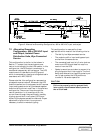
Liebert Series 600T UPS, 65-225 kVA, Single Module 7
6.3 Open-Rack Batteries
When batteries other than Liebert Battery
Cabinets are used, a remote battery disconnect
switch with overcurrent protection is required per
the National Electrical Code. Refer to Figures 53
and 54. Contact your Liebert sales representative.
1. Install battery racks/cabinets and batteries per
manufacturer's installation and maintenance
instructions.
2. Verify battery area has adequate ventilation
and battery operating temperature complies
with manufacturer's specification.
3. Ensure that battery racks are properly
grounded according to code requirements in
your area.
If you have any questions concerning batteries,
battery racks, or accessories, contact Liebert
Global Services at 1-800-543-2378.
CAUTION
Cables between batteries and modules
should be run in matched pairs, positive-
with-negative. Grouping like-polarity
cables together (i.e. positive-with-positive
and negative-with-negative) can cause
stress or damage to the cables, conduit or
buswork.
7. CONFIGURING YOUR NEUTRAL AND
GROUND CONNECTIONS
Improper grounding is the largest single cause of
UPS installation and start-up problems. This is not
an easy subject, since grounding techniques vary
significantly from site to site, depending on several
factors. The questions you should ask are:
• What is the configuration of the input power
source? Most of the recommended schemes for
UPS grounding require grounded-wye ser-
vice. The UPS system requires a bypass neu-
tral for sensing and monitoring the quality of
the bypass input. If the building service is
ungrounded delta or corner-grounded delta,
contact your Liebert representative to ensure
your system includes the Artificial Neutral or
Isolated Neutral kit.
• Does the system have a bypass isolation
transformer? Systems with 480 VAC (or 600
VAC) input and 208 VAC output require a
bypass isolation transformer. In some cases,
it may be necessary to treat that transformer
as a “separately derived source” with its own
grounding electrode. See page 10 for details.
• What are the UPS input and output voltages?
Systems with 480 VAC input and output have
significantly different needs than systems
with 480/208 VAC or 208/208 VAC.
• What is the connected load? Does the critical
load consist of one or more Power Distribu-
tion Units (PDUs)? Do the PDUs have isola-
tion transformers?
The following sections discuss recommended
grounding procedures for various system
configurations.
NOTE
Some UPS modules are equipped with
input isolation transformers. However,
these transformers have no effect upon any
system grounding considerations. These
modules will be grounded exactly as shown
in the following examples.
DISCONTINUED
PRODUCT


















